What Do Moths Eat?
July 14, 2020April 20, 2020 by C.B. Daniels
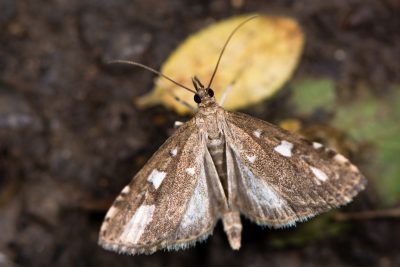
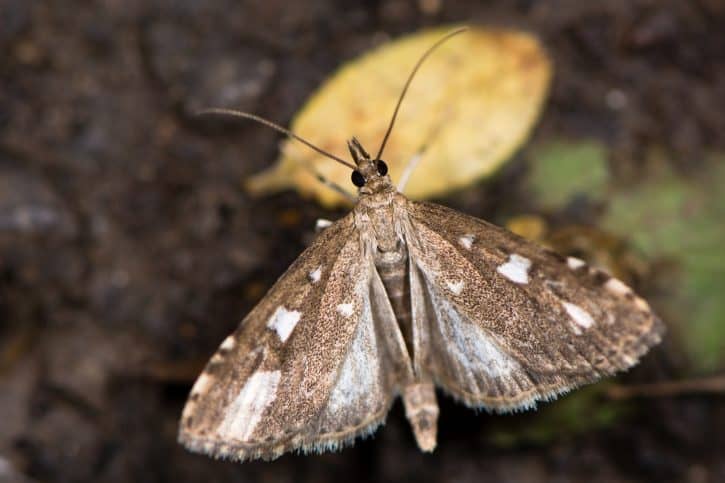
The Short Answer: Moths drink fluids like nectar and fruit juices, but they will also drink liquid from fecal matter – and many species of moth don’t eat or drink anything.
Contents
2 What’s the Difference Between Moths and Butterflies?
3.1 How Do Moths Get Their Food?
3.2 What Do Baby Moths (Caterpillars) Eat?
4 How Often Should You Feed Moths?
5 Summary of What Do Moths Eat?
What Are Moths?
Moths are insects, and together with butterflies, they make up the order Lepidoptera. Moths are often described as ugly butterflies, but they are actually their own genetically distinct family of insects.
As you would expect, moths have the three body segments common to all insects: a head, a thorax, and an abdomen. On their head, they have a pair of antennae and two compound eyes that are great at detecting UV light, as well as a long mouth structure called a proboscis that is used for drinking nectar and other fluids.
Moths differ from many other insect species in that they can curl up their proboscis when they are not feeding, tucking it close to their head. Honeybees and butterflies are two other insects that can retract their proboscises as well, but there aren’t many others.
The antennae of moths are highly sensitive olfactory structures, which are organs that let you process smell. Moths use them to find odorous flowers at night when it is hard to see.
Moths have an exoskeleton, which is a hard, external skeleton around their body, as well as three sets of jointed legs on their thorax. The most distinctive feature of moths, however, are their four large wings.
Their wings may not generally be as pretty as their colorful butterfly cousins, but they are very complex structures. The fore wings are connected to the hind wings by a structure called a frenulum, and at rest, they either lay flat against the moth’s body or spread out to the sides.
The entire body of a moth, including its wings, is covered in scales, which are modified hair structures that give them their powdery appearance. These scales have pigment in them and contribute to the overall color pattern of their wings.
It is thought that a moth’s scales may also alter how air passes over the wings because the scales are covered in pits and come in many different shapes and sizes. This modified airflow will affect both how a moth controls flight and its ability to regulate its body temperature via windchill.
Fun Fact: Scales will flake off of moths if you handle them, and cause the dusty smear that’s left when they get smashed. It is believed this evolved to help moths escape spider webs easier.
Some species of moths do not have scales over their entire wings, making them see-through in some places. The moths with this feature have been dubbed Clearwing Moths.
There are over 160,000 species of moths in the world, with nearly 11,000 in the US alone. They can be found on every continent except Antarctica and are not restricted to any specific temperature zones or biomes.
Moths can be found everywhere, from forests and fields to beaches and houses, with residential gardens being a major living place for them in urban areas. Most species of moths tend to be nocturnal, meaning that they are most active during the night.
Nocturnal moths will hide and rest during the day, and their normal gray and brown hues let them camouflage easily. Moths may rest on tree trunks, in leaf litter, or in vegetation during the day.
At night moths will take to the air in search of mates and food. They are naturally attracted to lights, and can often be found circling them.
It is thought that moths circle lights because when they forage at night, they navigate by keeping the moon to the same side of their body. This allows them to fly in a straight line and would explain the circling phenomenon when moths encounter artificial lights.
Some species of moth are migratory, meaning they travel from one location to another seasonally. For example, in the fall, the Silver Y Moth will travel to North Africa and the Mediterranean region from Northern Europe and will return in the spring.
Moths come in a vast range of sizes with the smallest one, Stigmella maya, measuring just 1.2 millimeters long. These tiny creatures live in Yucatán, Mexico, but the largest moth, the Atlas Moth, can have a wingspan of up to 12 inches and is found in the forests of Asia.
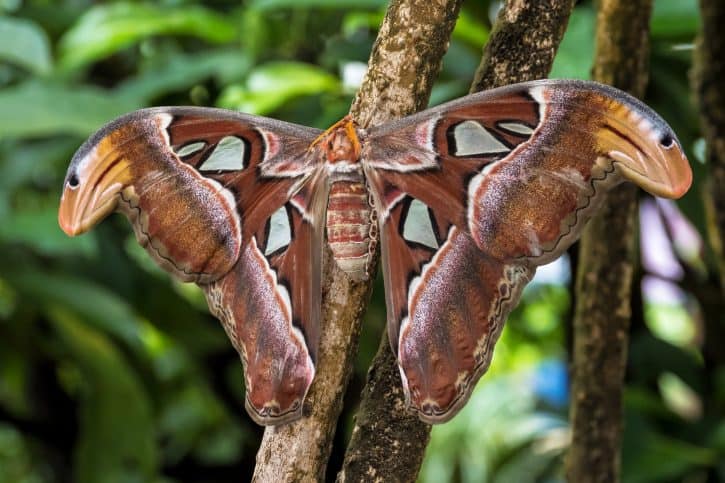 The Atlas moth
The Atlas moth
While many moths do tend to be a shade of gray or brown, they aren’t as colorless as you may think. Brightly-colored moths most commonly have different patterns of white, red, yellow, or orange, but some like the Sunset Moth also have shades of blue, green, and purple.
Fun Fact: Moths may also have large ‘eyespots’ on their wings, which are thought to help ward off predators. This is because the eyespots mimic the eyes of the higher predators or the animals that would be hunting the moth’s predators.
Moths are a significant source of food for bats, but also end up on the menu for some owls, birds, lizards, amphibians, rodents, and spiders as well. When they aren’t getting eaten, the average lifespan of a moth can vary widely but is usually from 65-90 days from start to finish. Most of that time is spent in immature stages, as adult moths only usually live for days to weeks.
Aside from eyes on their wings, moths have multiple other tricks up their sleeves to avoid being something’s dinner. Some moths have adapted their looks to resemble wasps, tarantulas, and other insects that aren’t as tasty, and some have mimicked the bright warning colors of other poisonous insects.
While moth caterpillars (baby moths) can be agricultural pests with their voracious eating habits, many species of adults are crucial for the growth of fruits, vegetables, and flowers as pollinators. Their fuzzy scales make it easy for pollen to stick to them, and they prefer plants with light-colored flowers that can easily be seen at night.
What’s the Difference Between Moths and Butterflies?
Aside from their general differences in color, many things distinguish moths from butterflies.
Being generally nocturnal, moths are most active from dusk to dawn. Butterflies, on the other hand, are diurnal, meaning they tend to be active during the daytime hours. Some notable exceptions are the Sunset Moth and moths in the genus Hemaris like the Hummingbird Clearwing Moth Hemaris thysbe, which tend to follow diurnal patterns.
Another behavioral difference is that when feeding, many moth species will hover over the top of their food source, whereas butterflies will land on it. Puddling is a phenomenon often seen in butterflies, where they will gather in large groups at shallow water puddles to feed.
Moths do this to some extent as well, but they tend to spread out over the solid surface instead of congregating at a single puddle. Puddling is more common in males than females of both moths and butterflies
While both butterflies and moths are scaled, butterflies tend to be less fuzzy in appearance. Butterflies also tend to rest with their wings pointing up vertically, unlike the flat or spread-out wings of a moth at rest.
The most significant physical difference between moths and butterflies is their antennae. Moths have antennae that are thick and feathery, and they either taper off or end without any change in appearance.
The antennae of butterflies, however, tend to be thinner and smoother on their body but have larger club-like tips. If you ever need to tell the difference between a butterfly and a moth, this is going to be your best bet.
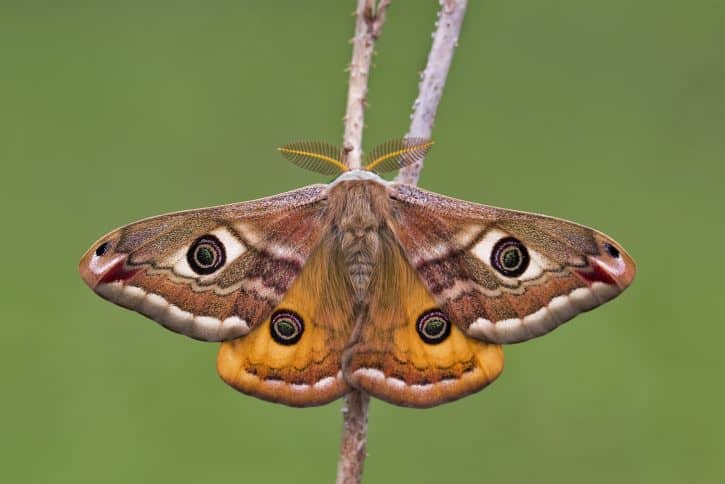
What Do Moths Eat?
Moths are unable to eat in the traditional sense of the word – they can’t bite or chew food. So how do they get their nutrients? They drink them.
Moths will drink fluids like nectar, juices from fruits (fresh or rotting), sap, and even fluids from bird poop and manure.
What may surprise you is that many species of moths don’t eat anything once they become adults. They get enough food as caterpillars that they can go through their whole adult lifespan without eating anything.
How Do Moths Get Their Food?
Moths can see motion well but have a hard time bringing shapes and images into focus. To find food then, they have to sniff it out.
Moths use the sensory structures on their antennae to find flowers for nectar, fruits, and other food sources. They have special organs on their feet that allow them to sample and taste what they find.
To drink up their liquid diets, moths have to use their long proboscis. This tubular, straw-like structure unrolls from the front of the moth’s head and inserts into the liquid source.
While many people would think that the moth then sucks up the liquid, that would almost be impossible. The nectar, sap, and yes, poop, that moths are drinking is so much thicker than water that there’s no way for the moth to create enough suction to draw it up into its mouth.
Instead, imagine the last time you watched a paper towel sop up a spill. You touch the paper towel to the liquid, and the liquid is quickly absorbed as it spreads through the paper towel. This physical phenomenon is called capillary action, and it’s the same concept that drives nectar and other fluids into a moth’s mouth.
The digestive system of the moth is broken up into three sections: a foregut, a midgut, and a hindgut. The foregut consists of the crop and the gizzard organs, the midgut consists of the stomach and the ceca, and the hindgut is comparable to the large intestines and also has the rectum.
The tiny grooves of the proboscis drive the moth’s liquid meal upward, and once it enters the mouth saliva is mixed in from the salivary glands. Then the food passes down the esophagus to the crop, which acts as a storage organ.
The crop releases bits of food in small quantities into the gizzard, where digestive enzymes begin the process of breaking down the food.
Once the fats, sugars, and proteins are all in small enough pieces, they pass into the stomach in the midgut where digestive juices from the stomach and ceca further break down the food.
The hindgut absorbs the nutrients, and anything that can’t be absorbed is passed as feces.
What Do Baby Moths (Caterpillars) Eat?
Baby moths are called caterpillars, though caterpillar is a catch-all term for the larvae of any moth or butterfly. Caterpillars have a significantly different diet than their adult forms, but to understand why you need to know about their lifecycle.
Adult moths have very, very specific reproductive organs and structures between individual moth species. Picture it like the old lock and key adage – males of one species of moths are all keyed the same, and the females of the same species only unlock to that key pattern.
Fun Fact: The most sure-fire way to tell different species of moths apart is to look at their genitalia.
Different components of the reproductive system can have spines, teeth, bristles, and clumps of scales that all act to form the lock-and-key interaction. The purpose of this complexity is to prevent members of two different species from being able to mate since the embryos of such mating are usually not viable.
Reproduction is the sole purpose of an adult moth’s life, so they want to make sure no precious resources are lost trying to produce offspring that won’t survive.
Once two members of the same species have mated, the female will look for an appropriate place to lay her eggs. Females will try to lay their eggs right on the plants that their caterpillars like to eat, and for many species, especially the Common Clothes Moth, this includes animal fibers like silk.
One female can lay from 40 eggs to over 1000 depending on the species, and when those eggs hatch is very species-specific. Some eggs will hatch immediately no matter what season it is, and some eggs won’t hatch until the next spring, no matter when they were laid.
These species differences are all in place to maximize the resources available for caterpillars to feast on, so whenever their preferred food source is most abundant is when the eggs are going to be timed to hatch.
Once the eggs hatch, the caterpillars emerge and immediately start eating. Their goal is to pack in as much energy as they possibly can before they undergo metamorphosis, and in the species where the adult moths don’t eat the amount they consume as caterpillars directly affects how long they will survive to reproduce as adults.
Some species of caterpillars will go through multiple instars, or growth stages, where they shed their exoskeleton (called molting) between each stage. The instars may look similar or wildly different depending on the species, but once the caterpillar has become its final instar, it is ready to pupate.
The caterpillar will find a place to pupate, which can be under dead leaves, on a plant stem or tree trunk, or even underground in some species. The caterpillar will surround itself in a cocoon and transform into a pupa, which is a deconstructed version of itself.
Different chemical processes cause the caterpillar’s body to break down, then specialized groups of cells lead the way in putting it back together in its adult form. The process of the caterpillar turning into an adult moth is called metamorphosis and can take from weeks to years, depending on the species.
When the adult emerges from the cocoon, its wings are shriveled, and it must spend the first hours outside of the cocoon pumping fluid from its abdomen to its wings to get them functional.
To fuel such a massive transformation, and to sustain their adult forms, caterpillars have to eat as much as they can. Some caterpillars will only eat one specific type of plant, whereas others are much less picky.
Many species prefer the leaves of the plants or trees, with over 500 species alone that like to munch on oak leaves. Other popular caterpillar foods include birch and willow leaves as well as honeysuckle and ivy leaves.
The caterpillars that eat animal fibers will eat silk, felt, leather, feathers, wool, and anything else they can find with keratin in it. It’s the caterpillars, not the adult moths, that are responsible for the holes you may find in your wool blanket or leather jacket.
The reason these caterpillars go for your clothes is that they are trying to eat the keratin in the fibers, which is the same protein that your hair and nails are made of.
In addition to being household pests, some caterpillars are agricultural nightmares. The Cabbage Moth caterpillar doesn’t only eat cabbage leaves; it also ravages broccoli, brussel sprouts, tobacco, and tomato plants as well, causing millions of dollars in damages each year.
Caterpillars tend to stick to the green and leafy parts of plants, but a few species will also eat fruits and seeds like the Codling Moth caterpillar. This is another agricultural pest that attacks apples and pears, among other important fruit plants.
What Do Adult Moths Eat?
Adult moths eat significantly less than their caterpillar counterparts, if they even eat at all. The moths that do eat still get most of their energy from what they stored as caterpillars.
Adults can only drink liquids and prefer those that are high in sugars like nectar, sap, and fruit juices. While those are their favorite foods, moths will also drink fluids from rotting fruits, liquid from manure and other poop, and they will even drink bird poop straight.
Moths are attracted to night-scented plants due to their nocturnal nature and prefer flowers of lighter colors that they can see slightly better at night.
Consuming salt has been shown to increase the chances of reproductive success in moths, so many moths will also seek out liquids that are high in sodium like those associated with manure.
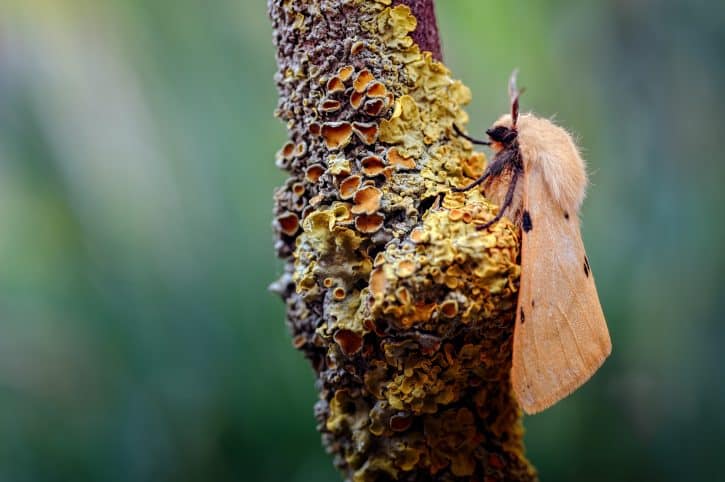
Moth Food Options
Moths don’t eat much, but there are a few things you can keep in your garden or offer your pet moths and caterpillars to make them happy.
Flowers for Nectar
Aubretia
Bluebell
Clover
Daisy
Dandelion
Evening Primrose
Forget-me-not
Honeysuckle
Ivy
Jasmine
Lavender
Mint
Pansy
Sweet Rocket
Thyme
Fruits (with flesh exposed)
Apples
Grapes
Peaches
Pears
Strawberries
Watermelon
How Often Should You Feed Moths?
If you’re keeping pet caterpillars, you’ll want to make sure they have constant access to their preferred fresh plant leaves. If you’re going to keep the moths once they’ve transformed, then you can offer them fruit slices or a small water bowl with one part sugar for every four parts water.
As for your garden, you should plant both nectar plants to attract adult moths and the plants that their caterpillars like to munch on if you want to encourage moths to lay eggs in your garden.
You can use butterfly feeders to attract moths too, but since moths and butterflies share many of the same plant and nutrient preferences, don’t be surprised if you get a butterfly garden going as well!
Summary of What Do Moths Eat?
Moths are scaled insects in the order Lepidoptera that are closely related to butterflies.
You can differentiate moths from butterflies by their antennae, and you can differentiate moth species from each other by looking at their genitals.
Moths are found all over the world and come in all shapes, sizes, and colors.
Moths have four life stages: egg, caterpillar, pupa, and adult. Caterpillars may have multiple instar growth stages, depending on the species.
Caterpillars seal themselves in a cocoon, where they turn into a pupa. Pupae will emerge from their cocoons as adult moths, and this process is known as metamorphosis.
Many species of moths don’t eat anything, but the ones that do drink nectars, fresh and rotting fruit juices, and fluids from different kinds of feces.
Moths use a special mouth sponge-like tube called a proboscis to absorb their liquid diets.
Caterpillars primarily eat plant leaves, and some species can be major agricultural pests. Some species of caterpillars also eat animal fibers in clothes, and you use mothballs to keep caterpillars away, not adult moths.
You can use sugar-infused water to feed moths, or you can plant your garden with night-scented, nectar-containing plants.
Other articles
Hi my name is C.B. Daniels and I make websites. I’ve also always been fascinated by animals. I thought that some of the information about animal diets and pet names was a little thin. So I figured I’d make this site to remedy that! I hope to make this site a hub for information about what animals eat, fun names you can use for your pets, and general animal information. Hopefully, you’ll find all the information about animals you are looking for and much more!
Latest posts by C.B. Daniels (see all)
- Can Rabbits Eat Grapes? - November 12, 2022
- Can Rabbits Eat Cucumbers? - November 3, 2022
- Can Rabbits Eat Spinach? - November 3, 2022